Kuala Lumpur International Airport
| Kuala Lumpur International Airport Lapangan Terbang Antarabangsa Kuala Lumpur 吉隆坡国际机场 | |||||||||||||||||||
|---|---|---|---|---|---|---|---|---|---|---|---|---|---|---|---|---|---|---|---|
 | |||||||||||||||||||
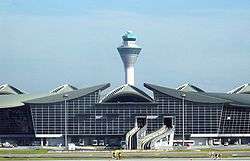 | |||||||||||||||||||
|
IATA: KUL – ICAO: WMKK – WMO: 48650 | |||||||||||||||||||
| Summary | |||||||||||||||||||
| Airport type | Public | ||||||||||||||||||
| Owner | Government of Malaysia | ||||||||||||||||||
| Operator | Malaysia Airports | ||||||||||||||||||
| Serves | Greater Klang Valley | ||||||||||||||||||
| Location | Sepang, Selangor, Malaysia | ||||||||||||||||||
| Hub for | |||||||||||||||||||
| Time zone | MST (UTC+08:00) | ||||||||||||||||||
| Elevation AMSL | 70 ft / 21 m | ||||||||||||||||||
| Coordinates | 02°44′36″N 101°41′53″E / 2.74333°N 101.69806°ECoordinates: 02°44′36″N 101°41′53″E / 2.74333°N 101.69806°E | ||||||||||||||||||
| Website | klia.com.my | ||||||||||||||||||
| Map | |||||||||||||||||||
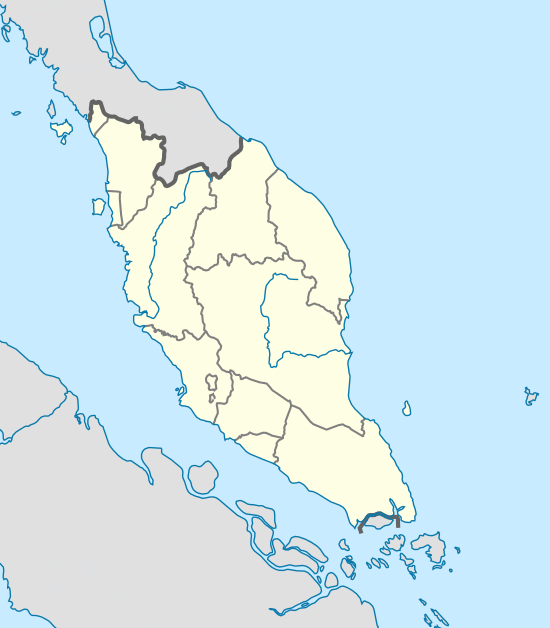 WMKK Location in Peninsular Malaysia | |||||||||||||||||||
| Runways | |||||||||||||||||||
| |||||||||||||||||||
| Statistics (2015) | |||||||||||||||||||
| |||||||||||||||||||
Kuala Lumpur International Airport (KLIA) (Malay: Lapangan Terbang Antarabangsa Kuala Lumpur) (IATA: KUL, ICAO: WMKK) is Malaysia's main international airport and one of the major airports in South East Asia. Built at a cost of US$3.5 billion[3] in Sepang district of Selangor, it is located approximately 45 kilometres (28 mi) south of Kuala Lumpur city centre and serves the Greater Klang Valley conurbation.
KLIA is the largest and busiest airport in Malaysia. In 2015, it handled 48,938,424 passengers and 726,230 tonnes of cargo. It is the world's 23rd-busiest airport by total passenger traffic.
The airport is operated by Malaysia Airports (MAHB) Sepang Sdn Bhd and is the major hub of Malaysia Airlines, MASkargo, AirAsia, AirAsia X, Malindo Air, UPS Airlines and Gading Sari.
History
Background
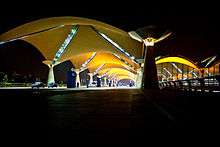
The ground breaking ceremony for Kuala Lumpur International Airport (KLIA) took place on 1 June 1993 when the government under Mahathir Mohamad decided that the existing Kuala Lumpur airport, then known as Subang International Airport (now Sultan Abdul Aziz Shah Airport) could not handle future demand. The construction of the airport was done mainly by a few state owned construction companies as well as Ekovest Berhad – helmed by Tan Sri Datuk Lim Kang Hoo. It was created as part of the Multimedia Super Corridor, a grand development plan for Malaysia. The chief architect who designed the new airport terminal was the Japanese architect Kisho Kurokawa.[4]
Upon KLIA's completion, Subang Airport's Terminal 1 building was demolished. Malaysia Airports agreed to redevelop the remaining Terminal 3 to create a specialist airport for turboprop and charter planes surrounded by a residential area and a business park. The IATA airport code KUL was transferred from Subang Airport, which currently handles only turboprop aircraft, general aviation and military aircraft. Subang Airport's IATA code has since been changed to SZB.
Current site
The airport's site spans 100 square kilometres (39 sq mi) 2,[3] of former agricultural land and is one of the world's largest airport sites. An ambitious three-phase development plan anticipates KLIA to have five runways and two terminals each with two satellite terminals.[5] Phase One involved the construction of the main terminal and one satellite terminal, giving a capacity of 25 million passengers, and two full service runways. The Phase One airport had sixty contact piers, twenty remote parking bays with eighty aircraft parking positions, four maintenance hangars and fire stations. Phase Two, designed to increase capacity to 35 million passengers per year is largely complete. Phase Three is anticipated to increase capacity to 100 million passengers per year.[5]
Grand opening
Kuala Lumpur International Airport was officially inaugurated by the 10th Yang di-Pertuan Agong, Tuanku Ja'afar of Negeri Sembilan, on 27 June 1998 at 20:30 MST, a week ahead of Hong Kong International Airport and in time for the 1998 Commonwealth Games. The first domestic arrival was Malaysia Airlines flight MH1263 from Kuantan (Kuantan Airport) at 07:10 MST. The first international arrival was Malaysia Airlines flight MH188 from Malé International Airport at 07:30 MST. The first domestic departure was Malaysia Airlines flight MH1432 to Langkawi (Langkawi International Airport) at 07:20 MST; the first international departure was Malaysia Airlines flight MH84 to Beijing (Beijing Capital International Airport) at 09:00 MST.[6]
Inauguration

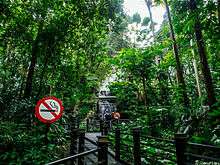
The inauguration of the airport was marked with problems. Aerobridge and bay allocation systems broke down, queues built up throughout the airport and baggage handling broke down. Bags were lost and there were waits of over five hours.[7] Most of these issues were remedied eventually, though baggage handling system was plagued with problems until it was put up for a complete replacement tender in 2007.
The airport suffered greatly reduced traffic with the general reduction in economic activity brought about by the East Asian financial crisis, SARS, bird flu epidemic (Avian flu), the global financial crisis and the swine flu pandemic. 1998 saw a reduction of passenger numbers as some airlines, including All Nippon Airways (recommencing on 1 September 2015), British Airways (resumed on 28 May 2015), Lufthansa (later reinstated) and Northwest Airlines, terminated their loss making services to KLIA. KLIA's first full year of operations in 1999, in its Phase One manifestation (capacity of 25 million passengers per year), saw only 13.2 million passengers.[8] Passenger numbers eventually increased to 21.1 million in 2004 and 23.2 million in 2005 — though short of the originally estimated 25 million passengers per year by 2003.
Runways
Kuala Lumpur International Airport has three parallel runways (one for Terminal 1, one for KLIA Terminal 2, and one runway that can be used for both terminals[9]). Two KLIA operational runways are located 2 kilometres from each other, which are designed for simultaneous take-offs and landings. Terminal 1 runways are monitored by the main Air Traffic Control (ATC) Tower, which was the tallest ATC tower in the world (currently 3rd, behind KLIA 2 and Bangkok Suvarnabhumi). Runway 3 for klia2 is monitored by a dedicated separate ATC Tower which, standing at 133.8m, is currently the tallest in the world.
Operations and infrastructure
| Infrastructure | ||
|---|---|---|
| Passenger terminal buildings | ||
| Totals | Current | |
| Floor area | 737,249 m2 | |
| Handling capacity | 70 million passengers per annum | |
| Parking bays | 114 (aerobridge) 48 (remote) | |
| Main Terminal Building 1 & Contact Pier | ||
| Opened | 27 June 1998 | |
| Floor area | 336,000 m2 | |
| Handling capacity | 5 million passengers per annum | |
| Parking bays | 20 (aerobridge) 23 (remote) | |
| Satellite Terminal A | ||
| Opened | 27 June 1998 | |
| Floor area | 143,404 m2 | |
| Handling capacity | 20 million passengers per annum | |
| Parking bays | 26 (aerobridge) 15 (remote) | |
| klia2 | ||
| Opened | 2 May 2014 | |
| Floor area | 257,845 m2 | |
| Handling capacity | 45 million passengers per annum | |
| Parking bays | 68 (aerobridge) 10 (remote) | |
| Bunga Raya Complex | ||
| Opened | 27 June 1998 | |
| Floor area | ||
| Handling capacity | ||
| Parking bays | 1 | |
KLIA features a number of modern design features that assist in the efficient operation of the airport. It is one of the first Asia Pacific airports to become 100% Bar Coded Boarding Pass capable.[10] Malaysia Airlines;[11] AirAsia;[12] MASkargo, a cargo airline;[13] and Malaysia Airports, the Malaysian Airports operator and manager; are headquartered on the property of KLIA.[14] Malaysia Airlines also operates its Flight Management Building at KLIA.[15]
Terminals
The Passenger Terminal Complex (PTC) was built with an emphasis on allowing natural light into the building. Thus, there is a huge expanse of glass throughout the building, and the spectacular roof has cut-outs for natural light to filter in. The PTC comprises three buildings – the Main Terminal Building, the Satellite Building and the Contact Pier. Besides the 80-room hotel at the Satellite Building, there is a 422-room 5-star Sama-Sama Hotel KLIA, a five-minute (indoor) walk away. Shopping spots are available in an area encompassing 85,000 square metres. Currently, the retail space at the Kuala Lumpur International Airport stands at 67,000 square metres (720,000 sq ft). The airport operator plans to increase the retail space to 105,300 square metres (1,133,000 sq ft), a 62.2% increase in retail space.
Being an international airport, all terminals are equipped with immigration processing facilities and security scanning for all passengers, including domestic passengers. The Satellite terminal handles most of the international flights, while the main terminal building's contact pier handles domestic traffic, regional international flights and international flights routed to other hubs within Malaysia. Malaysia Airlines operates from both terminals, and the main terminal building's contact pier is their preferred terminal for domestic flights. Conversely, low cost carriers such as Tigerair, Cebu Pacific and AirAsia group of airlines operate domestic and international flights out of klia2, the low-cost carrier terminal at KLIA.[16]
The initial passenger growth was below average due to Asian Financial Crisis and the outbreak of severe acute respiratory syndrome (SARS) epidemic in 2003 and the airport failed to reach its target capacity of 25 million passengers per annum (before the inclusion of low cost carrier terminal) by 2004. However, the recovery of Malaysia's economy boosted Kuala Lumpur International Airport's passenger movements, and the airport saw significant growth in traffic, hitting the 25 million passenger mark in 2007. In 2013, the airport saw a monumental increase in passenger traffic to 47 million passengers.[17]
Main terminal building and contact pier

The KLIA Main Terminal Building (MTB) is located in between the two runways. The floor area of the terminal covers 390,000 m2 (4,200,000 sq ft) and the building consists of 39 square roof units, which enables future expansion of the building. There are a total of 216 check-in counters, located in 6 different islands, identified by the letters A – M (excluding I). Multi check-in services are available, designed for the use of all passengers arriving, departing or in transit. On 2 February 2007, Malaysia Airports introduces 12 integrated self check-in kiosks (CUSS) for passengers. The first airline to use the system is KLM.[18] A further 24 kiosks will be added later by the airport operator[19][20]
The contact pier is the rectangular-shaped terminal that is connected to the KLIA Main Terminal Building (MTB). It serves as the domestic terminal for Malaysia Airlines. Some international flights are handled there as well. Previously it used to service low-cost carriers. The north side of the pier, it can only accommodate narrow-bodied aircraft. In contrast, the south side of the contact pier can accommodate Boeing 737 and Boeing 747 or similar sized aircraft.
The gates in Main Terminal Building's contact pier has alphabet prefix of A and B for domestic flights, which is accessible from domestic departures on Level 3 where passengers descend after security check, and G and H for international flights. Gates G & H are sharing the same boarding lounge as Gates A & B, where after boarding and secondary security check (before boarding aircraft) passengers descend into the same boarding lounge with the doors for "A & B" on level 3 sealed off for international flights. For domestic flights, the stairs to access "G & H" are sealed off instead.
Currently there's only Malaysia Airlines using the main terminal for short-haul and medium-haul flights. Malaysian hybrid airline Malindo Air will be moving all flight operations (except ATR 72-600s, which will still stay in Subang International Airport) to Kuala Lumpur International Airport's main terminal.
Satellite terminal A

The 176,000 square metres (1,890,000 sq ft) satellite building accommodates international flights departing and arriving at KLIA. Passengers have to travel to the satellite building via the Aerotrain. There is a wide array of duty-free shops and prestige brand boutiques in the satellite building. This includes international brands such as Burberry, Harrods, Montblanc, Salvatore Ferragamo. Among all international labels available within the terminal, some boutiques such as Harrods are only available in the airport. A number of restaurants and international airlines' lounges are available as well as an Airside Transit Hotel.
Within the terminal, wireless internet (Wi-Fi) is provided free of charge. The terminal also has prayer rooms, showers and massage service. Various lounge areas are provided, some including children's play areas and movie lounge, broadcasting movie and sport channels.[21] The terminal also features a natural rainforest in the middle of the terminal, exhibiting the Malaysian rainforests.
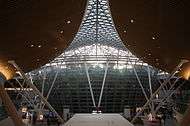

Under Malaysia Airports Berhad retail optimisation plan, the retail space in satellite terminal A will be further optimised to increase its revenue derived from commercial space rental and a percentage of sale receipts to 50% by year 2010 which currently stands at 35%. Some notable improvements that will be seen after the refurbishments will be the Jungle Boardwalk which will be the first of its kind in the world and larger mezzanine floor to accommodate F&B outlets and viewing galleries.[22]
The gates in Satellite Terminal A have the prefix C.The Satellite A terminal has 27 boarding gates altogether.
klia2

klia2 is the low-cost carrier terminal at KLIA. The terminal is located 2 kilometres away from the Main Terminal Building (MTB). klia2 is built to cater for the explosive growth in low cost travel in the region and has replaced the former Low-Cost Carrier Terminal (LCCT). klia2 started operations on 2 May 2014 and all flight operations at LCCT were moved to klia2 by 9 May 2014.[23][24]
Built at a cost of approximately RM4 billion (US$1.3 billion), klia2 is the world's largest purpose-built terminal dedicated to low-cost carriers and is designed to cater for 45 million passengers a year with future capacity expansion capability.[25] The terminal is served by a dedicated 4 km runway (KLIA's Runway 3) and a 141.3m air traffic control (ATC) tower,[26] making it the world's tallest ATC tower.
The terminal has a built-up area of 257,845 sqm with 68 departure gates, 10 remote stands, 80 aerobridges, includes a retail space of 35,000 sqm to accommodate a total of 220 retail outlets.[27] The main terminal building of klia2 is connected with its satellite piers with a skybridge, making it the first airport in Asia with such facility.[28] klia2 is certified with Leadership in Energy & Environmental Design (LEED).
Check-in counters are divided into 8 rows located in 4 islands, each row identified by the letters S – Z. Boarding gates are located in 5 piers, indicated by the letters J and K for domestic flights, and L, P and Q for international flights. Piers J, K and L are connected directly to the main terminal building, while Piers P and Q are accessible via the skybridge. Piers K and L are physically the same pier and share the same gates, but with waiting lounges on different levels (Level 1A for K and Level 2 for L). For international flights, the access door from Pier K is sealed off, while for domestic flights, the access door from Pier L is sealed off instead.
At present, inter-terminal connection is provided on the landside at Gateway@klia2 complex and there are provisions for future airside inter-terminal connection.
Gateway@klia2
Gateway@klia2 is an integrated complex that is connected to the main klia2 terminal building. It has a 350,000 square feet of net lettable space spanning over 4 levels, offering a fresh airport-within-a-mall concept. The transport hub at Gateway@klia2 links klia2 to the Express Rail Link (ERL) (also known as KLIA Ekspres), with allotted pick-up and drop-off areas for coaches, taxis, rented vehicles and private transportation.[29]
Gateway@klia2 hosts an 8-storey car park that directly adjoins klia2. There are 6,000 covered parking lots at Blocks A and B and another 5,500 lots at car park D. Shuttle buses are available to take the public from the car park D to the terminal. The car park is fully gated with 24-hour security personnel on duty. The parking rate for the covered parking facility at klia2 is RM4 per hour for the first 3 hours, and up to a maximum daily rate of RM46.[30] The first capsule transit hotel in Asia named as the Capsule by Container Hotel is also located at Gateway@klia2. Gateway@klia2 is managed by WCT Holdings Berhad.[31]
KL City Air Terminal
KL City Air Terminal, sometimes known as Kuala Lumpur City Air Terminal or KL CAT located at KL Sentral is a virtual extension of KL International Airport where city check-in services are provided. KL City Air Terminal is recognised by International Air Transport Association which carries IATA designation XKL. Currently there are only 5 airlines providing city check-in services, they are Cathay Pacific, Emirates Airline, Etihad Airways, Malaysia Airlines and Royal Brunei Airlines.[32] However, the situation is due to be changed as 10 SITA's AirportConnect CUTE (Common Use Terminal Equipment) were installed on 10 check-in desks in KL CAT that enables all airlines to offer city check-in service for their passengers.[33]
Low cost carrier terminal (LCCT) closed

The 36,000 square metres (390,000 sq ft) Low cost carrier terminal (LCCT) was opened at Kuala Lumpur International Airport on 23 March 2006 to cater for the growing number of users of low cost airlines, especially the passengers of Malaysia's "no-frills" airline, AirAsia. The terminal was designed and built in accordance to the low cost carrier business model, with limited terminal amenities. As requested by the low cost airline, the terminal does not provide aerobridges, nor are there transfer facilities, rail connections, and other facilities provided in a full-fledged terminal.
The LCCT was located on the opposite side of the apron from the Main Terminal Building (MTB), with close proximity to the air cargo area. The terminal underwent expansion in 2008 to accommodate exponential growth of low cost travel.[34] Following the opening of klia2, the new terminal built for low cost air-travel, the LCCT ceased operations on 9 May 2014 and all low-cost carrier flights are now operating out of klia2.
The AirAsia corporate head office was in the LCCT.[35] The airline plans to move its head office to a new facility constructed at klia2 scheduled to open in the end of 2015.[36] AirAsia X had its head office in the same facility.[37]
Airlines and destinations
Passenger
^Note 1 Air Mauritius flights continue to Singapore. However, Air Mauritius does not have fifth freedom traffic rights to transport passengers solely between Kuala Lumpur and Singapore.
^Note 2 Ethiopian Airlines flights continue to Singapore. However, Ethiopian Airlines does not have fifth freedom traffic rights to transport passengers solely between Kuala Lumpur and Singapore.
^Note 3 Royal Jordanian's flight from Amman to Kuala Lumpur continue on to Jakarta. However, Royal Jordanian does not have fifth freedom traffic rights to transport passengers solely from Kuala Lumpur to Jakarta.
Cargo
Statistics
|
| |||||||||||||||||||||||||||||||||||||||||||||||||||||||||||||||||||||||||||||||||||||||||||||||||||||||||||||||||||||||||||||||||||||||||||||||||||||||||||||||||||||||||||||||||||||||||||||||||||||||||||||||||||||||||||||||||||||||||||||||||||||||||||||||||||||||||||||||||||||||||||||||||||||||||||||||||||||||||||||||||||||||||||||||||||||||||||||||||||||||||||||||||||||||||||||||||||||||||||||||||||||
Ground transportation
Inter-terminal transportation

The Aerotrain is an automated people mover (APM) that connects the airside of KLIA Main Terminal Building (MTB) and the Satellite Building. Each 250-person capacity train can transport 3,000 passengers per hour in each direction at up to 56 km/h (35 mph). These three-car driverless trains run on elevated rail and under the taxiways. The journey takes under two minutes. The Aerotrain operates between three and five-minute intervals between terminal. Automatic train controls manage the operation of the entire Aerotrain system, controlling the speeds, headways, stops and door openings in stations, and integrating functions that enhance the reliability and performance of the system.[51]
KLIA Transit and KLIA Ekspres provides landside connections between klia2 and KLIA Main Terminal Building (MTB), and vice versa. This inter-terminal journey takes 3-minutes to connect both terminals before proceeding onwards to KL Sentral.[52]
External connections
Rail
Kuala Lumpur International Airport is linked to the KL Sentral transportation hub in the city centre by the 57 km long Express Rail Link (ERL). There are two ERL stations at the airport: KLIA station at the Main Terminal Building and klia2 station at Gateway@klia2. The airport is served by two rail services on the ERL:
- KLIA Ekspres: The dedicated airport rail link which runs non-stop between KL Sentral and KLIA. The journey takes 28 minutes to/from KLIA, and 33 minutes to/from klia2 with a two-minute stop at KLIA. The KLIA Ekspres terminal at KL Sentral is known as the KL City Air Terminal (KL CAT), which has an IATA designation XKL. KL CAT offers in-town flight check-in service up to two hours before flight departure time for passengers travelling on Cathay Pacific, Emirates, Etihad Airways, Malaysia Airlines and Royal Brunei Airlines.
- KLIA Transit: A commuter rail service which stops at three additional stops (Bandar Tasik Selatan, Putrajaya/Cyberjaya and Salak Tinggi) between KL Sentral and KLIA. The journey takes 35 minutes to/from KLIA and 39 minutes to/from klia2. Check-in facilities are not available at KLIA Transit stations.
Taxis and limousine
Airport taxis or airport limousines are provided by Airport Limo. The taxis and limousines are readily available at the Taxi and Limousine counters. They run from airport itself to destinations in Klang Valley and Greater Klang Valley. The fares are to be paid at the counter and are charged according to the destinations' zone. A surcharge is applied for services between 12 am to 5 am
Bus
Both public and private buses connect KLIA and klia2 to several points in Kuala Lumpur and beyond.
Expansion and developments
Plans
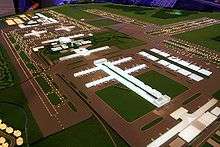
With the slight modification of the masterplan, the future Terminal 2's satellite terminal will be combined into one satellite terminal. The expansion of Terminal 2's satellite terminal will be exactly the same as Terminal 1's satellite terminal, where initially the satellite terminal will have four arms, and another four arms when the terminal reached its capacity. There is sufficient land and capacity to develop facilities to handle up to 97.5 million passengers a year, four runways by the year 2020 and two mega-terminals, each linked with satellite terminals.[5]
| Summary of Kuala Lumpur International Airport Masterplan | ||||
|---|---|---|---|---|
| Phase | Year | Description | ||
| Phase 1 | 1998 | Initial Capacity of 25 million Passenger Per Annum | ||
| 2006 | Capable of Handling 35 million Passengers per annum with the construction of Low Cost Carrier Terminal | |||
| Phase 2 | 2008 | Expansion of Low Cost Carrier Terminal to accommodate 40 Million Passengers per annum. | ||
| Phase 3 | 2011 | New Low Cost Carrier Terminal will be constructed to accommodate additional 30 million (55 million) passengers Per Annum, Current Low Cost Carrier Terminal converted to cargo usage. | ||
| Not fixed | Satellite Terminal B will be constructed to handle maximum of 75 million passengers. (One terminal accompanied by 2 satellite terminal and one low cost carrier terminal) | |||
| Phase 4 | Not fixed | Terminal 2 and Satellite Terminal C will be constructed so that the airport is capable to handle 97.5 million passengers. | ||
Low Cost Carrier Terminal (LCCT)
It is expected that the current LCCT will be converted into a cargo hub after all low-cost carrier flights have operate out of klia2.[53] The RM124 million LCCT expansion project tender was won by Fajarbaru Builder Group Bhd and construction work began in March 2008.[54] The new international arrival hall was opened on 15 December 2008, and the rest of the wing were fully operational by March 2009.[34] The LCCT international departure hall was opened on 18 March 2009 which expanded the handling capacity from 600 passengers at one time to 3200 passengers.[55]
A380 upgrades
The operator of Kuala Lumpur International Airport, Malaysia Airports Holding Berhad, had spent about RM135 million (approx US$39 million) to upgrade facilities at the KL International Airport (KLIA) in Sepang to accommodate the Airbus A380. Upgrading works started on 3 April 2006, and was completed by 28 May 2007. Works include the provision of shoulders on both sides of the two existing runways of 15 meters as well as the taxiways, building additional aerobridges at the three departure halls, namely C17, C27 and C37, and enhancing the mezzanine lounges for upper deck passengers of the aircraft at the departure halls. Emirates operates flights to Kuala Lumpur with the Airbus A380 commenced on 1 January 2012.[56] Malaysia Airlines also started its A380 services from Kuala Lumpur to London on 1 July 2012.[57]
Gallery

-

Skybridge from Main Terminal Building to Pan Pacific Hotel (now known as Sama Sama Hotel)
-

An Alternative View of the Satellite Terminal
-

Baggage Claim Area
-

KLIA Air Traffic Control (ATC) Tower
-
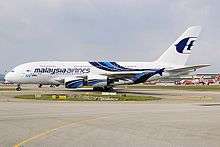
A Malaysia Airlines Airbus A380 taxiing out for departure
-

An Emirates A380 approaching Kuala Lumpur International Airport
-

KLM Boeing 747-400 departing from Kuala Lumpur International Airport
-

An Iraqi Airways Boeing 747-400 in the new livery landing at Kuala Lumpur International Airport (2014)
-

A Qatar Airways Boeing 777 taxiing at KLIA
-
.jpg)
A Garuda Indonesia Boeing 737-800 taxiing at KLIA
-

A SriLankan Airlines Airbus A340-300 upon arrival to Kuala Lumpur International Airport
-
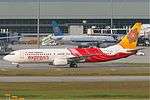
An Air India Express Boeing 737-800 taxiing out, with China Southern Airlines Airbus A319 in the background
-

An Uzbekistan Airways Airbus A310-200 preparing for departure
-

An AirAsia Airbus A320-200 in pushback
References
- 1 2 3 4 5 "MAHB Annual Report 2015" (PDF). Malaysia Airports. 6 April 2016. Retrieved 7 April 2016.
- ↑ WMKK – KL INTERNATIONAL/SEPANG at Department of Civil Aviation Malaysia
- 1 2 "History of KLIA". 1998.
- ↑ http://www.kisho.co.jp/page/223.html
- 1 2 3 "Phases of KLIA". 1998.
- ↑ "First Flights of Kuala Lumpur International Airport". Department of Civil Aviation KLIA Branch. 1998.
- ↑ "KLIA's opening marked with problems". Lim Kit Siang Media Release. July 1998.
- ↑ "Passengers at Kuala Lumpur Airport up despite fewer airlines". Asian Economic News. 6 August 2001.
- ↑ For KLIA2, arrivals for can only use 32L while departures can only use 14R
- ↑ Check-In News, Analysis and Event. "Kuala Lumpur's StB vision". Retrieved 31 August 2010.
- ↑ "Malaysia Airlines Recovery Plan Quarterly Update (1 Sept-30 Nov 15)." Malaysia Airlines. Retrieved on May 5, 2016.
- ↑ Chan Tien Hin. "AirAsia Has Record Drop on Loss, Analyst Downgrade." Bloomberg L.P.. 1 December 2008. Retrieved 27 September 2009.
- ↑ "Location Map." MASkargo. Retrieved 22 February 2010. "Malaysia Airlines Cargo Sdn. Bhd. 1M, Zone C, Advanced Cargo Centre KLIA Free Commercial Zone, Southern Support Zone Kuala Lumpur International Airport 64000 Sepang Selangor, Malaysia "
- ↑ "Contact Information." Malaysia Airports. Retrieved 23 May 2011. "Malaysia Airports Holdings Berhad Malaysia Airports Corporate Office, Persiaran Korporat KLIA, 64000 KLIA, Sepang, Selangor."
- ↑ "Contact." Malaysia Airlines. Retrieved 31 October 2012. "MAS Golden Boutiques Sdn. Bhd. 1st Floor, MAS Flight Management Building 64000 Sepang, Kuala Lumpur International Airport Selangor, Malaysia"
- ↑ "AAirAsia helps Kuala Lumpur towards 30 million; Singapore route soon to be fully liberalised". anna.aero. 10 October 2008.
- ↑ "Airport Traffic Report" (PDF). 1998.
- ↑ "KLIA Introduces Integrated Self Check in Kiosks for Benefits of Passengers". Air Transport News.
- ↑ "Self Check in at KLIA". New Straits Times. Retrieved 21 August 2007.
- ↑ "KLIA partners with SITA to be the first fully integrated Airport in Asia". Retrieved 21 September 2005.
- ↑ "KLIA increase WiFi range". CAPA. Retrieved 19 February 2008.
- ↑ "9 firms shortlisted for KLIA retail expansion project". NST. Retrieved 16 February 2008.
- ↑ "klia2 receives ICAO nod, first landing". Retrieved 25 April 2014.
- ↑ "klia2 overview". Retrieved 1 May 2014.
- ↑ "Be the first 2 visit the new klia2". Retrieved 25 April 2014.
- ↑ "klia2 Control Tower Is Tallest in the World". Retrieved 24 April 2014.
- ↑ "About klia2". Retrieved 24 April 2014.
- ↑ "klia2 opens to public". Retrieved 27 April 2014.
- ↑ "About gateway@klia2". Retrieved 1 May 2014.
- ↑ "Public invited to tour and experience klia2 before May 2 opening". Retrieved 27 April 2014.
- ↑ "klia2 Coming Soon". Retrieved 25 April 2014.
- ↑ "Flight Check-In at KL Sentral". KLIA Ekspres. Retrieved 2014-08-05.
- ↑ All Airlines can now offer city check-in in KL Sentral Archived 3 August 2009 at the Wayback Machine.
- 1 2 Geetha Krishnan (9 December 2008). "LCCT international arrival hall ahead of schedule". The Star.
- ↑ "Annual Report 2013" (Archive). AirAsia. Retrieved 29 August 2014. p. 33/306. "HEAD OFFICE LCC Terminal, Jalan KLIA S3 Southern Support Zone, KLIA, 64000 Sepang, Selangor Darul Ehsan, Malaysia"
- ↑ "AirAsia denies funding issues in moving HQ to klia2" (Archive). The Malaysian Insider. 2 June 2014. Retrieved 28 August 2014.
- ↑ "AirAsia X Berhad • Annual Report 2014" (Archive). AirAsia X. Retrieved 2 February 2015. p. 20 (PDF p. 49/234): "REGISTERED OFFICE AirAsia X Berhad (Company No. 734161-K) B-13-15, Level 13 Menara Prima Tower B Jalan PJU 1/39, Dataran Prima 47301 Petaling Jaya Selangor Darul Ehsan, Malaysia" and "HEAD OFFICE LCC Terminal Jalan KLIA S3, Southern Support Zone KLIA, 64000 Sepang Selangor Darul Ehsan, Malaysia"
- ↑ "AirAsia Boosts Malaysia -Indo Links". Travel Daily Asia. 4 November 2016. Retrieved 6 November 2016.
- ↑ "AirAsia X Files Madinah Schedule from Nov 2016". Routes Online. 19 May 2016. Retrieved 19 May 2016.
- 1 2 "Dragonair begins Kuala Lumpur service from March 2017". routesonline. Retrieved 22 September 2016.
- ↑ "Ethiopian adds Chengdu from June 2017". routesonline. Retrieved 30 November 2016.
- ↑ http://www.routesonline.com/news/38/airlineroute/269983/iran-air-moves-east-asia-service-resumption-to-jan-2017/?platform=hootsuite
- ↑ "Malindo Air Outlines New International Routes Aug - Oct 2016". routesonline. Retrieved 14 July 2016.
- ↑ https://twitter.com/Airlineroute/status/805396417078562816?lang=en
- ↑ "AirAsia W16 Cebu – Kuala Lumpur service changes". routesonline. Retrieved 5 October 2016.
- ↑ "Shenzhen Airlines resumes Kuala Lumpur service from Dec 2016". routesonline. Retrieved 10 October 2016.
- 1 2 "MasKargo adds new China service in Nov 2016". routesonline. Retrieved 18 November 2016.
- ↑ "Network". maskargo.com.
- ↑ "MAB Kargo partners Azerbaijan carrier to expand cargo network".
- ↑ "Transport Statistics Malaysia 2014: Table 4.12 Traffic Movements Between Malaysian Airports (Including Singapore), 2014" (PDF). Ministry of Transport Malaysia. Retrieved 28 April 2016.
- ↑ "Kuala Lumpur International". Kiat.net. Retrieved 19 April 2012.
- ↑ . kliaekspres.com https://www.kliaekspres.com/klia2/. Retrieved 8 January 2015. Missing or empty
|title=(help) - ↑ "LCCT may become cargo hub when new terminal is up". The Star. Retrieved 1 February 2008.
- ↑ "Fajarbaru wins RM124m KLIA job". Business Times. Retrieved 25 March 2008.
- ↑ "New LCCT departure hall opens". The Star. 18 March 2009.
- ↑ "MAHB upgrade KLIA to take in A380". NST. Retrieved 16 August 2006.
- ↑ "First Malaysia Airlines' A380 Revealed in Full Special Livery – Very encouraging demand for seats on Malaysia Airlines A380 flights". Malaysia Airlines. Retrieved 17 November 2012.
External links
| Wikimedia Commons has media related to Kuala Lumpur International Airport. |
-
 Kuala Lumpur International Airport travel guide from Wikivoyage
Kuala Lumpur International Airport travel guide from Wikivoyage - Official website
- klia2 official website
- KLIA Info Website
- Gateway@klia2 website
- KLIA Main Terminal and klia2 real time flight schedule